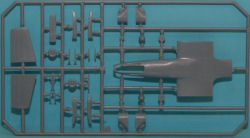
Special Hobby 1/72 IA.58A Pucara Kit First Look
By Michael Benolkin
| Date of Review | April 2009 | Manufacturer | Special Hobby |
|---|---|---|---|
| Subject | Sikorsky IA.58A Pucara | Scale | 1/72 |
| Kit Number | 72047 | Primary Media | Styrene, Resin, PE |
| Pros | Nice detailing inside and out | Cons | |
| Skill Level | Experienced | MSRP (USD) | $29.95 |
First Look
 |
 |
 |
 |
 |
 |
 |
The Fabrica Militar de Aviones (FMA) started development of a counter-insurgency (COIN) aircraft in 1966. The resulting design was a low-wing design wit a 'T' tail and powered by a pair of Turbomeca turboprop engines. The airframe featured tandem seating for a crew of two seated on Martin Baker ejection seats. While the airframe is large for a two-place COIN aircraft, the aircraft had a range of over 2,000 miles, was armed with four 7.62mm machine guns and a pair of 20mm cannons, as well as three pylons that could carry up to 3300 pounds of gun pods, bombs, rockets, mines, and/or torpedoes.
Despite its size, the Pucara could operate out of short and unimproved runways making the aircraft ideal for deployment in forward operating locations. Such was the case during the Malvinas (Falklands) war when Pucaras were staged out of Port Stanley and on Pebble Island. While many were damaged or destroyed in the opening stages of the war, a number of the aircraft did support Argentine combat operations. The Pucara also saw combat in the Sri Lankan COIN operations between 1993 and 1999, and continue to serve in the Argentine and Urguayan Air Forces.
Special Hobby is the first and only company to date to produce this distinctive turboprop aircraft in styrene. Actually it is a multimedia kit, but who's counting?
The kit is molded in gray styrene and presented on three parts trees, plus a single clear styrene canopy. The seats and engine details are cast in tan resin, while the remainder of the details are provided on a single fret of photo-etched parts.
The cockpit is nicely detailed with photo-etched instrument panels, side consoles, and printed acetate instrument faces. The ejection seats feature photo-etched seat belts and harnesses. Even the rudder pedals are photo-etched. Unfortunately, the canopy is molded in one piece, so the cockpit can't be posed open to show off all of that detail.
There is room under the cockpit floor just aft of the nosegear bay as well as ahead of the front cockpit to install some ballast. The instructions call for eight grams and it will take at least that much given the distance that tail sticks out behind the main gear. This isn't a problem on the real aircraft as there are six guns and all of the ammo, plus fuel and avionics to keep the center of gravity in place.
While construction of this kit is rather staightforward, this is a limited run multimedia kit which means that this project isn't for the inexperienced modeler. There will be fitting, trimming, sanding, and filling required to get everything together, but nothing out of the ordinary.
Markings are provided for four different Argentine AF examples, two camouflaged and two in aluminum finish.
I am really happy to see this aircraft in kit form and hope that some day someone will produce one in a scale larger that 1/72. For now, we have a nice kit of this unique aircraft for our scale flightlines.







